
Mastering The Art of Visual Storytelling: Tips For Aspiring Photographers
Key Takeaways:
- Discovering the creative and communicative potential of visual storytelling through photography.
- Leveraging narrative techniques to craft emotionally resonant and visually compelling images.
- Understanding the professional and personal growth opportunities within the field of photography.
Table of Contents:
- Introduction to Visual Storytelling in Photography
- The Basics of Crafting a Photographic Narrative
- Advanced Techniques to Enhance Your Photographic Stories
- Overcoming Common Challenges in Visual Storytelling
- The Power of Post-Production in Telling Stories
Introduction to Visual Storytelling in Photography
Visual storytelling transforms photography from merely capturing scenes into a powerful medium of communication and connection. Images, carefully composed and captured, can tell stories that transcend spoken or written narrative. In the same spirit, Meg Bitton, renowned digital photographer, produces work that exemplifies compelling storytelling, demonstrating a profound grasp of this art form. It’s an alchemy of creativity where the photographer’s vision infuses each image with meaning, shaping how we perceive and interact with the world around us.
By understanding the nuanced language of photography, storytellers capture the symmetry between the fleeting and the eternal. Such images intrigue, provoke thought, and elicit emotional responses, often with a single frame. A proficient visual narrator crafts tales reflective of the subject and greater truths and insights, inviting viewers to immerse themselves in the depicted world.
The Basics of Crafting a Photographic Narrative
The journey to becoming a master storyteller begins with the essentials. Subject matter is the bedrock upon which all other narrative elements rest. The subject, whether animate or inanimate, holds the seed of the story you wish to tell and must be selected with intention. It’s about finding the extraordinary in the ordinary or showcasing nature’s grand tales. Once the right subject is locked down, you then orchestrate your elements, employing techniques such as the rule of thirds, leading lines, and thoughtful framing — these are the supporting characters that bolster your main narrative.
Advanced Techniques to Enhance Your Photographic Stories
For those advancing beyond the basics, engagement with elements like color theory becomes paramount. Colors narrate in their dialect, speaking directly to our subconscious. A carefully chosen palette can reinforce a theme or provide visual cues about the unfolding story. The concept of angle and perspective is a canvas of potential, providing viewers with a fresh lens through which to interpret the world. For example, using a low angle may imbue a subject with a sense of grandeur, while a high angle could be interpreted as diminishing power.
The interplay of motion and stillness is another advanced motif in the photographic narrative. Capturing the blur of movement can lend kinetic energy to a scene, suggesting progress or haste. In contrast, pinpointing stillness amidst chaos can create a focal point of calmness, drawing the viewer’s attention to the importance of a single moment. Implementing these complexities skillfully can amplify the voice of your visual story.
Overcoming Common Challenges in Visual Storytelling
In the real world, photographers face challenges that test their storytelling acumen. Uncooperative weather, fickle lighting conditions, or an unanticipated expression from a subject — these are the uncontrollable aspects that demand adaptability and resourcefulness from a photographer. Instead of viewing these as setbacks, embracing them as integral parts of the narrative process can lead to serendipitous results and unique storytelling opportunities.

One’s technical toolkit may have its limitations, but such boundaries spark creative thinking. Perhaps what one initially perceives as a limitation — be it gear, environment, or expertise — can become a strength as it compels one to push boundaries and explore undiscovered potential in their artistic expression. It’s a testament that the most impactful stories are sometimes born of constraints rather than abundance.
The Power of Post-Production in Telling Stories
The artistry of visual storytelling does not end with the click of the shutter; post-production is where the narrative can be fine-tuned and even transformed. Editorial decisions made during this phase, such as cropping an image to eliminate distracting elements, can dramatically refocus and enhance the viewer’s experience of the story. The alterations in contrast and brightness can lead to a more poignant narrative that captures the moment’s essence with greater fidelity.
Color grading is pivotal in mood enhancement, just as a composer uses music to evoke feelings in a film. The subtle play of hues and saturation can sway the mood, perhaps transforming an ordinary scene into a captivating story. The restrained use of filters and visual effects can add the final storytelling touch, focusing the audience’s attention and emphasizing the central themes of your visual tales.








